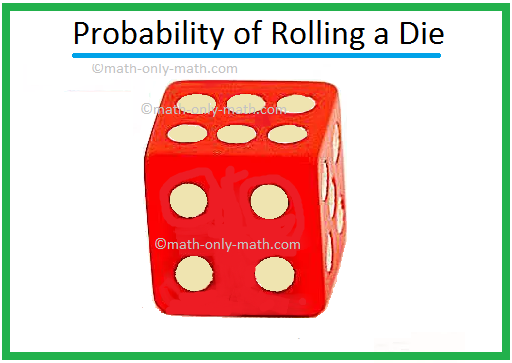Subscribe to our ▶️ YouTube channel 🔴 for the latest videos, updates, and tips.
Probability of Rolling a Die
We will solve different type of problems on probability of rolling a die.
1. A die is thrown 200 times and the numbers shown on it are recorded as given below:
If the die is thrown at random, what is the probability of getting a
(i) 4
(ii) 4 or 5
(iii) Prime number
Solution:
(i) Total number of trials = 200.
Number of times 4 appears = 28.
Therefore, the probability of getting 4 = \(\frac{\textrm{Frequency of 4 Appearing}}{\textrm{Sum of all the Frequencies}}\)
= \(\frac{\textrm{Number of Times 4 Appears}}{\textrm{Total Number of Trials}}\)
= \(\frac{28}{200}\)
= \(\frac{7}{50}\).
(ii) Total number of trials = 200.
Number of times 4 or 5 appears = 28 + 26 = 54.
Therefore, the probability of getting 4 or 5 = \(\frac{\textrm{Number of Times 4 or 5 Appears}}{\textrm{Total Number of Trials}}\)
= \(\frac{54}{200}\)
= \(\frac{27}{100}\).
(iii) Total number of trials = 200.
Number of times a prime number appears = 48 + 36 + 26 = 110.
[Since 2, 3 and 5 are prime numbers and they appear 48, 36 and 26 times respectively).
Therefore, the probability of getting
a prime number = \(\frac{\textrm{Number of Times a Prime Number Appears}}{\textrm{Total Number of Trials}}\)
= \(\frac{110}{200}\)
= \(\frac{11}{20}\).
● Probability
- Probability
- Definition of Probability
- Random Experiments
- Experimental Probability
- Events in Probability
- Empirical Probability
- Coin Toss Probability
- Probability of Tossing Two Coins
- Probability of Tossing Three Coins
- Complimentary Events
- Mutually Exclusive Events
- Mutually Non-Exclusive Events
- Conditional Probability
- Theoretical Probability
- Odds and Probability
- Playing Cards Probability
- Probability and Playing Cards
- Probability of Rolling a Die
- Probability for Rolling Two Dice
- Probability for Rolling Three Dice
- Solved Probability Problems
8th Grade Math Practice
From Probability of Rolling a Die to HOME PAGE
Didn't find what you were looking for? Or want to know more information about Math Only Math. Use this Google Search to find what you need.



New! Comments
Have your say about what you just read! Leave me a comment in the box below. Ask a Question or Answer a Question.